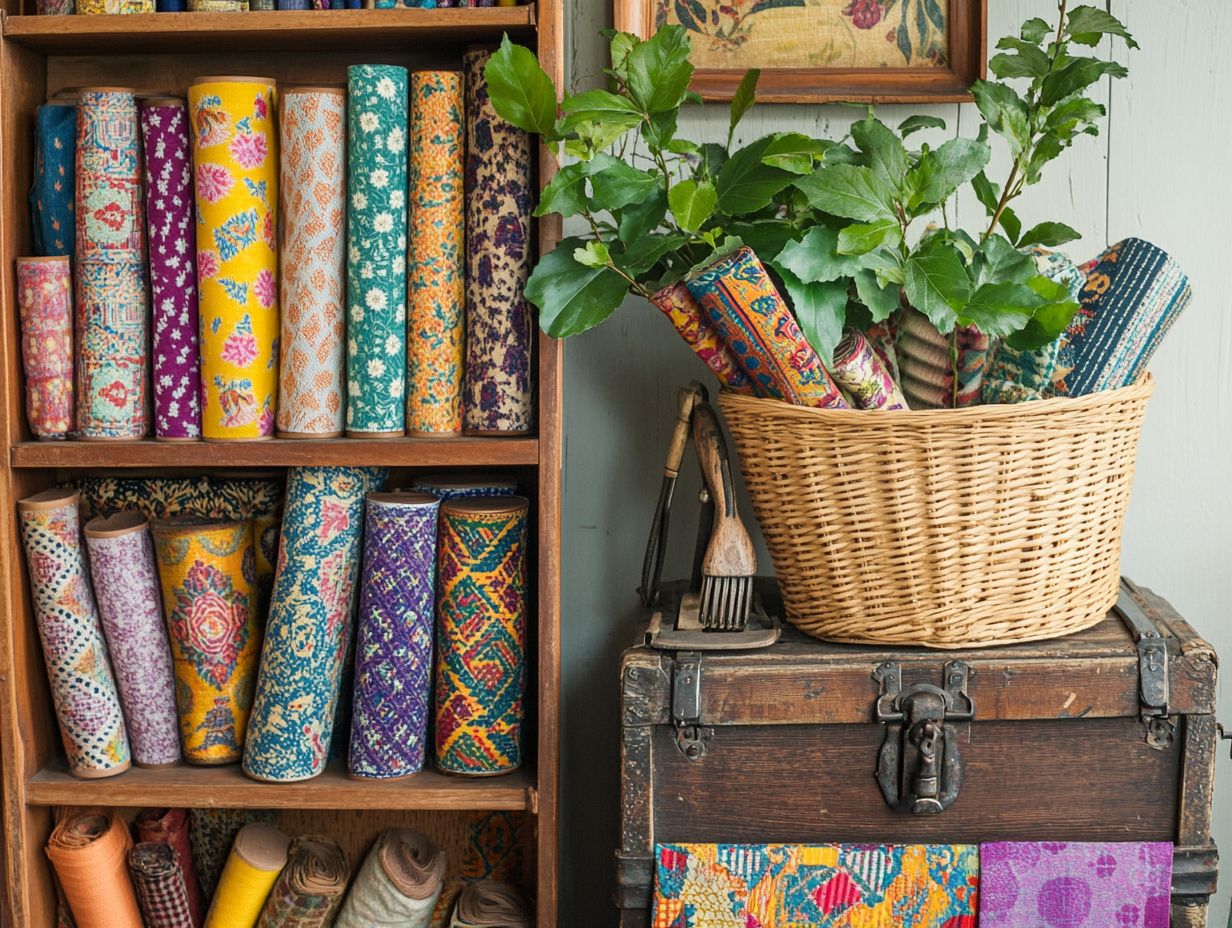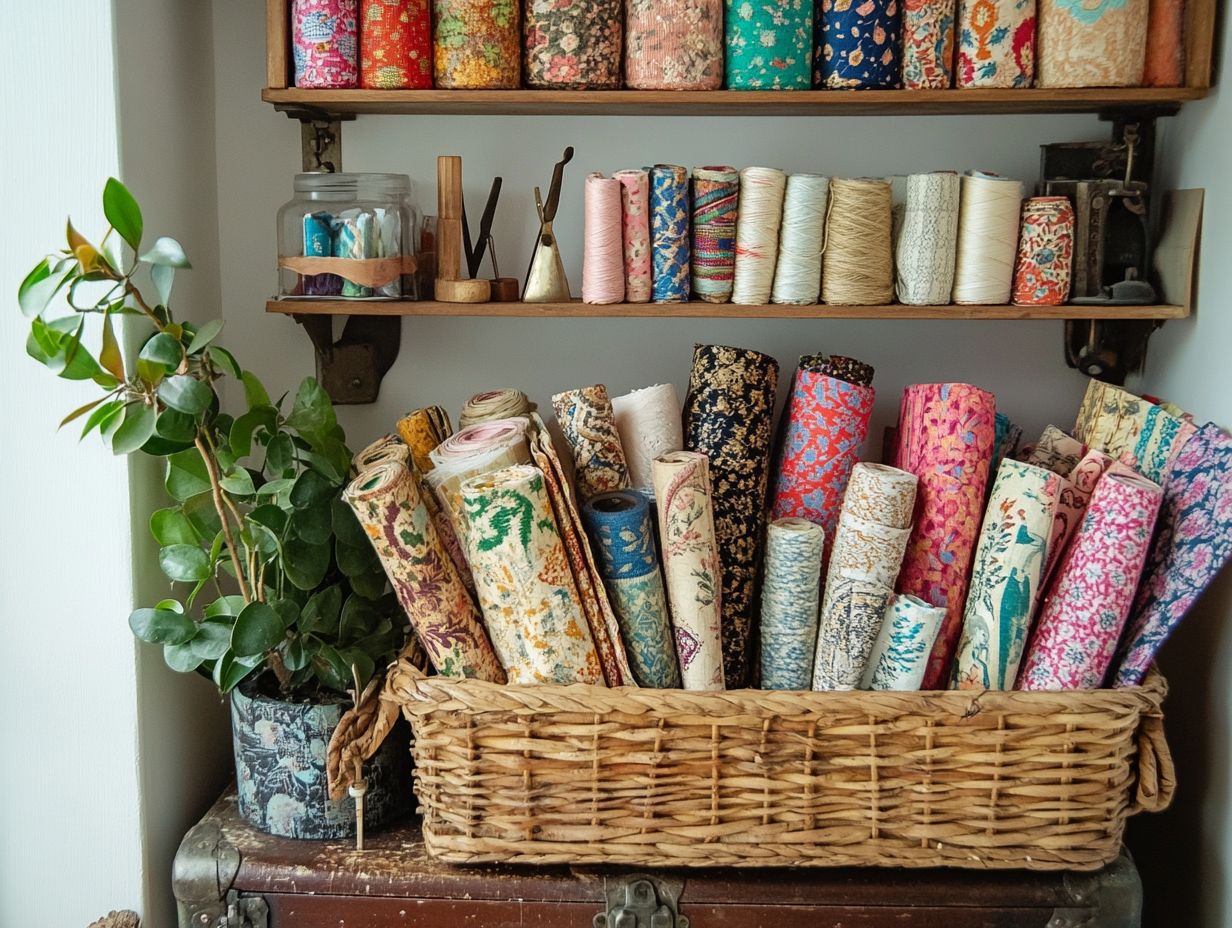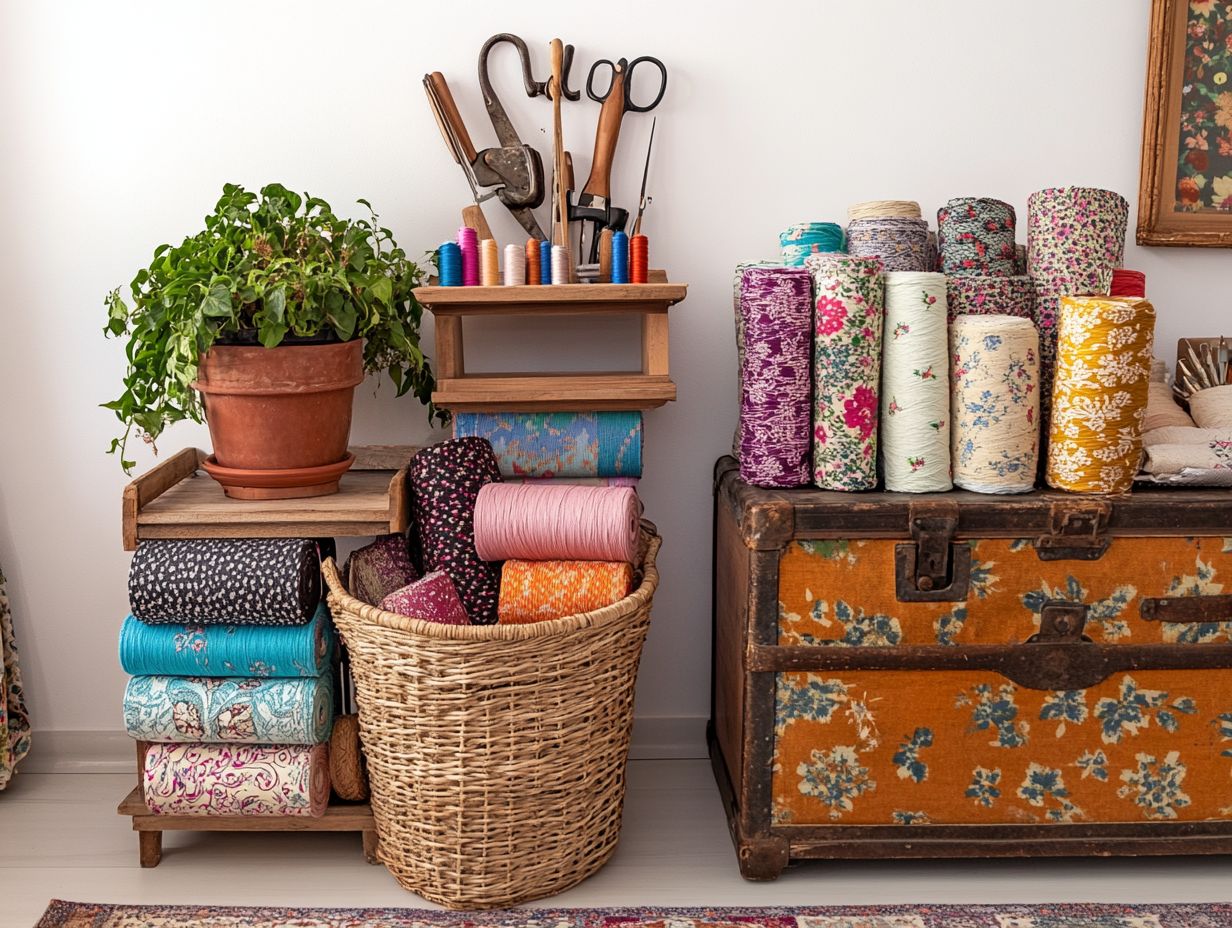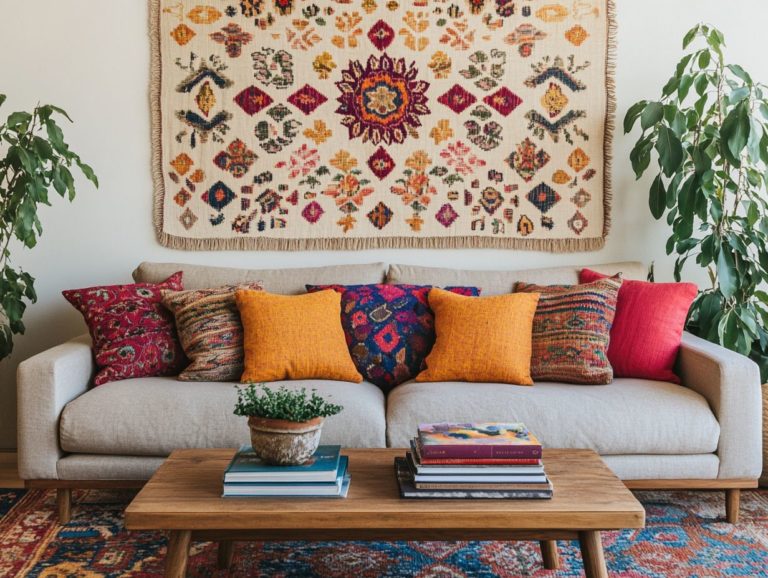Vintage Fabric Storage Ideas for Your Home
Are you eager to infuse your home organization with a dose of charm and eco-friendliness?
Vintage fabric storage presents a delightful fusion of style and sustainability. It can elevate any space. Consider the advantages of using vintage fabrics: their aesthetic appeal and environmentally conscious essence.
You ll uncover innovative DIY storage solutions, gain insights on how to care for your vintage treasures, and learn where to find these unique gems.
Ready to transform your space? Embark on this journey with us as you transform clutter into captivating decor!
Contents
- Key Takeaways:
- Benefits of Using Vintage Fabric for Storage
- Creative Ways to Use Vintage Fabric for Storage
- Organizing and Maintaining Vintage Fabric Storage
- Where to Find Vintage Fabric for Storage
- Frequently Asked Questions
- What are some creative ways to store vintage fabrics in my home?
- How can I incorporate vintage fabric storage into my existing home decor?
- What are some tips for organizing my vintage fabric collection?
- Can I repurpose vintage items as fabric storage solutions?
- How can I best maintain and care for my vintage fabric collection?
Key Takeaways:

- Elevate your home storage with the charm and sustainability of vintage fabric.
- Transform old clothing and linens into unique storage solutions for a stylish and eco-friendly touch.
- Proper care and organization of vintage fabric storage can ensure its longevity and functionality in your home.
What is Vintage Fabric Storage?
Vintage fabric storage is all about using the unique charm of textiles from the past to elegantly organize and store your crafting materials and sewing supplies. This approach is functional and elevates the aesthetic of your sewing room or craft space, transforming a simple closet into a vibrant showcase of colors and textures.
By upcycling (reusing materials to create something new) vintage fabric, you can craft storage solutions that are both practical and visually captivating. Incorporating baskets, shelves, and bins gives you easy access to your supplies while preserving the beauty of these treasured fabrics.
Various types of fabrics, such as felt, fleece, cotton, and linen, perfectly complement this organization method. Felt can be transformed into cozy storage pockets for smaller items, while fleece adds a soft touch to larger bins for holding various projects. Cotton s versatility makes it ideal for lining drawers or creating colorful labels, ensuring easy identification. Meanwhile, linen, known for its durability, serves beautifully as elegant cover-ups or dividers in open shelving, keeping everything neat and accessible.
By thoughtfully selecting these materials, you can enhance not just your inventory management but also the overall ambiance of your creative workspace.
Benefits of Using Vintage Fabric for Storage
Incorporating vintage fabric for your storage solutions brings a wealth of benefits, from eco-friendliness to aesthetic charm, all while enhancing your craft space and championing sustainable practices.
Choosing vintage pieces over new materials actively contributes to waste reduction and embraces the art of upcycling fabric remnants, making it an ideal choice for the conscientious crafter.
The distinct patterns and textures of vintage fabrics can transform the organization and visual appeal of your sewing room, allowing for an elegant expression of creativity in your storage solutions.
Eco-Friendly and Aesthetic Appeal
The eco-friendly charm of vintage fabric storage is a compelling reason to weave these textiles into your organizing techniques. Not only do they contribute to sustainable crafting practices, but they also add a distinctive aesthetic appeal that can elevate your space.
By opting for vintage fabrics, you reduce your reliance on new materials and promote recycling, aligning perfectly with the growing trend of environmentally-conscious crafting. The unique designs and colors of vintage fabrics have the power to transform functional storage solutions into captivating art installations within your sewing room or closet.
Embracing these materials allows you to create delightful fabric bins, quirky drawer liners, or even striking wall hangings that serve a purpose while reflecting your personal style. Picture using floral patterns to adorn boxes for storing supplies or repurposing an old quilt into a cozy yet sophisticated storage solution for fabric remnants.
These practical applications not only maximize your space but also breathe new life into discarded textiles, making every piece a story waiting to be shared.
In this way, organizing becomes an artistic endeavor that looks fabulous while being kind to the planet.
Creative Ways to Use Vintage Fabric for Storage

Exploring creative ways to utilize vintage fabric for storage opens the door to innovative DIY solutions that help you organize your craft supplies with flair. Plus, they add a touch of charm to your space.
Imagine fabric bins or unique organizers made from vintage suitcases or old dressers you can do so much!
By repurposing these textiles, you can create functional storage that honors the stories woven into the fabric while making a striking statement in your sewing room or closet.
DIY Storage Solutions
Creating DIY storage solutions with vintage fabric will elevate your sewing room into a well-organized creative haven, blending functionality with style. You can craft simple projects like fabric bins, baskets, or drawer organizers using remnants of felt, fleece, cotton, and linen, resulting in pieces that are both efficient and visually stunning.
By tapping into your sewing skills, customize these storage options to fit your unique needs and personal flair.
These fabrics offer exciting textures and patterns that will bring your space to life! For instance, you can whip up a quick fabric bin by cutting a square of sturdy cotton fabric, sewing the sides together, and adding a contrasting trim for an extra touch of flair.
When it comes to baskets, felt is your best friend it doesn t fray, making it an ideal choice for beginners.
With simple steps like folding, sewing, and embellishing, even the most novice of crafters can create unique storage pieces that truly reflect their individuality. By coordinating different fabric pieces, you ll achieve a cohesive look that enhances the overall aesthetic of the room.
Repurposing Vintage Items
Repurposing vintage items into effective storage solutions can bring your craft space to life while keeping it organized. Transform vintage suitcases, armoire drawers, or even old dressers into custom storage that holds your crafting materials and serves as a charming conversation piece.
This innovative method maximizes space while beautifully showcasing the vintage fabric and items you choose.
Consider using old wooden crates or vintage baskets to create distinct sections for your various textiles, making them easily accessible during projects.
Incorporate wall-mounted shelves made from reclaimed wood or upcycled window frames to display your cherished fabric pieces while keeping your area tidy.
The charm of these repurposed items adds practical benefits and a touch of nostalgia to your decor, inspiring creativity every time you step into your sewing sanctuary.
Organizing and Maintaining Vintage Fabric Storage
Organizing and maintaining your vintage fabric storage is crucial for preserving the integrity and beauty of your textiles while ensuring easy access to your craft supplies.
By adopting a systematic approach perhaps utilizing clear bins or labeled baskets you can greatly enhance both the organization and functionality of your sewing space.
Following proper care tips keeps your vintage pieces in great shape for years to come.
Ready to transform your vintage finds? Let s get crafting!
Tips for Proper Storage and Care

To ensure you re storing and caring for your vintage fabric properly, adopt best practices that protect both the material and your organizing efforts. Consider storing fabric remnants in air-tight plastic totes, labeled bins, or utilize pegboard with dowels to keep everything tidy and preserved.
Check regularly for signs of wear or damage. This will help maintain the quality of your fabrics, ensuring they remain stunning additions to your sewing room.
Keep these cherished pieces away from direct sunlight and moisture, as both can lead to fading and deterioration over time. Layering with acid-free tissue paper, which helps prevent damage to your fabric, is an excellent strategy to maintain their original shape.
When handling vintage fabric, always wash your hands first to avoid transferring oils or dirt. Try to minimize handling to preserve their integrity.
By following these guidelines, you ll enhance the longevity and visual appeal of your vintage textiles while ensuring they remain functional for various creative projects.
Where to Find Vintage Fabric for Storage
Finding vintage fabric for storage can feel like an exhilarating treasure hunt. You have many avenues to explore, from charming thrift stores to expansive online marketplaces and captivating local estate sales.
Each source presents unique opportunities to discover timeless fabrics that fulfill practical needs and elevate the aesthetic of your craft space. Upcycling old clothing and linens infuses new life into forgotten materials, crafting stunning storage solutions that are tailored to your needs.
Thrift Stores and Online Marketplaces
Thrift stores and online marketplaces are among the best venues to uncover vintage fabric for your storage needs. Each offers a distinct selection of textiles that can truly spark your creative organizing ideas.
When you step into a thrift store, you engage in a hands-on experience, sifting through fabrics and feeling their textures firsthand. Online marketplaces offer a wide range of options, all accessible at your fingertips.
Both paths provide opportunities to discover hidden gems that can elevate your sewing room organization. However, each method has its own advantages and disadvantages.
Shopping in thrift stores gives immediate gratification and the chance to closely inspect the quality of the fabric, but it may limit your choices and require considerable time spent browsing. On the other hand, online marketplaces grant access to a broader inventory and often feature competitive pricing, yet they complicate the process of assessing texture and durability.
To ensure quality finds, check for reputable seller reviews and inspect fabric images closely. Ask questions about the materials. To maximize your sourcing efforts, set a budget, create a list of preferred patterns, and visit local thrift shops regularly. You never know what treasures you might unearth!
Upcycling Old Clothing and Linens
Upcycling old clothing and linens into vintage fabric storage solutions is a sustainable practice that can enhance your crafting experience while minimizing waste. By creatively repurposing items like curtains, shirts, or tablecloths, you can craft functional organizers that showcase unique patterns and textures.
This eco-friendly approach invites you to think outside the box and explore your creative potential. For example, transforming an old shirt into a stylish fabric basket is simpler than you might think. Just follow these steps:
- Begin by cutting the shirt into the desired shape for the base and sides.
- Next, stitch the edges to secure the structure.
With a few decorative flourishes, like bows or patches, your basket can become a chic storage solution for scraps or tools. This not only reduces landfill waste but also engages your imagination, turning everyday materials into one-of-a-kind treasures.
Frequently Asked Questions

What are some creative ways to store vintage fabrics in my home?
1. Use old suitcases or trunks to store and display your vintage fabrics. They add a charming touch to any room.
2. Hang vintage fabrics on a decorative ladder with clothespins or clips. This adds visual interest and keeps your fabrics accessible.
3. Invest in vintage storage containers, like old metal or wooden crates. They help organize your fabrics and enhance your home s vintage aesthetic.
How can I incorporate vintage fabric storage into my existing home decor?
1. Use vintage fabrics as wall hangings or tapestries. They add a unique touch to your walls and serve as functional storage.
2. Display vintage fabrics on open shelves or in glass cabinets. This lets you show off your collection while keeping them in good condition.
3. Use vintage fabrics as table runners or placemats. This adds nostalgia to your dining space and allows for easy seasonal changes.
What are some tips for organizing my vintage fabric collection?
1. Sort your fabrics by color, pattern, or type based on your preference. This makes it easier to find what you need and enhances the visual appeal of your storage.
2. Keep track of your fabrics by labeling them. Use tags or create a color-coded system to make locating items simple.
3. Store your fabrics in a cool, dry place away from direct sunlight to prevent fading and damage. Use acid-free tissue paper or fabric bags for delicate items.
Can I repurpose vintage items as fabric storage solutions?
1. Yes! You can repurpose old furniture like dressers or cabinets to store your vintage fabrics. Think about adding shelves or dividers for better organization!
2. Vintage baskets or hampers make great fabric storage options. Line them with fabric or paper to prevent snagging and keep your fabrics clean.
3. Get creative with unexpected items like vintage suitcases, hat boxes, or even old birdcages for a unique touch in your fabric storage.
How can I best maintain and care for my vintage fabric collection?
1. Avoid washing vintage fabrics unless necessary to prevent damage. Spot clean stains with a gentle cleaner or dry clean if needed.
2. Store your vintage fabrics in airtight containers or bags to protect them from dust, moisture, and pests.
3. Rotate your fabrics periodically to prevent creases or damage in one spot. Use acid-free tissue paper or muslin between layers for added protection.






